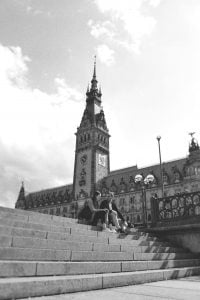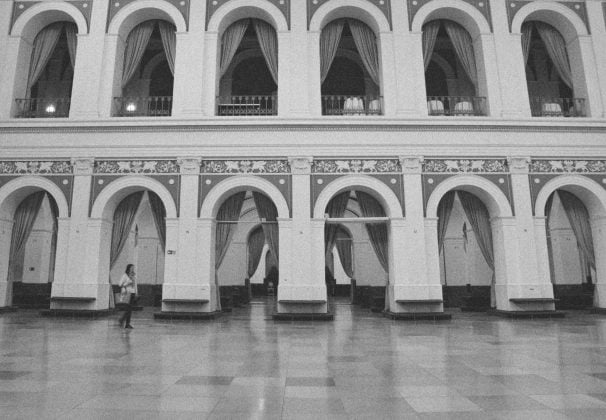Hamburg – part grit and part chic, why this German city of the north keeps on surprising.
It was August, and the world smelled of roses – of dreams – of summer.
When Ted Macauley first visited Hamburg in 1970, a decade had passed since the Beatles performed live in August of 1960 and brought several houses down in St. Pauli. It was also the time when John Lennon, in front of an animated crowd, fiddled his guitar wearing only his knickers. Ten years may seem like history, yet it hadn’t been long ago in his early career as a Pan American flight attendant to have seen the Wall come down that divided Germany between East and West.
Before German reunification, Hamburg was that port city hemmed in by the sea and by the nearby border with East Germany. Police formalities were tedious and took hours on the eastern side of the border. Back then, a one-hour Pan Am flight was the only efficient alternative.

 Fast forward to today, the time of border inspection has long been gone and so has the Wall. The Pan Am days have now become a figment to one’s imagination, tinged in a perfect hue of nostalgia. Yet, the music and artistic fortitude is alive and well in the city that nurtured the rise of the Beatles. If Lennon, bold as he came, endearingly quipped that although he was born in Liverpool, he felt he had grown up in Hamburg; then what are my chances of blossoming into a jungfern?
Fast forward to today, the time of border inspection has long been gone and so has the Wall. The Pan Am days have now become a figment to one’s imagination, tinged in a perfect hue of nostalgia. Yet, the music and artistic fortitude is alive and well in the city that nurtured the rise of the Beatles. If Lennon, bold as he came, endearingly quipped that although he was born in Liverpool, he felt he had grown up in Hamburg; then what are my chances of blossoming into a jungfern?
Perhaps even finding familiarity and kinship with Germany’s second largest city of which I know nothing about except for Lennon’s knickers and women in their see-through knickers appearing on postcards saying ‘Willkommem in Hamburg’. In the summer of 2019, just like the Beatles and ex-PanAm Macauley and the many others that came before me, I arrived in Hamburg on an armogan August witnessing a city evoking that promising singular summer feeling.
To live in the words of a waschechte Hamburger, a born and bred local and not something one can happily order out of a menu, any visit to “the gateway of the world” as Hamburg’s historic label puts it, should start at the Alster. In a heartbeat, so I did.
Passed several baronial buildings, rows of neat residential houses punctuated by embassies, I began my stroll along the banks of the Alster, the conspicuous lake that gives Hamburg its unique identity amongst other German cities – a kind of reflective presence and unexcited temper whatever the weather and season may be.
For a city unaccustomed to being stared at, the Alster takes them all in – the gaze of dreamy admiration and wanton. I see joggers in their daily grind pausing to snap a photo as sailboats crisscross the waters from one end to the other. Seagulls patrol and cry overhead while lovers kiss and summer love blooms.

Up ahead is Jungfernstieg promenade, once frequented by Hamburg’s aristocrats in hopes of finding a suitable partner for their unwed daughters or jungferns. It’s the city’s version of Tinder in the old days and where Jungfernstieg got its moniker from. An afternoon stroll promises a whiff of that old promenade charm except for a few additions of worldly accoutrements of modern times – poking selfie-sticks for achieving the best instagrammable pose, whizzing electric scooters, city bikes and lots of them, as well as luxury cars that drive in front of posh retail shops at the Neuer Wall Street.
I retreated to the inner side of the lake and walk under balletic arcades where cafés spill over. The smell of roasted coffee stops any passerby for a brief moment while glancing between the cafe menus and the adjacent canal that snakes along the city only to pour itself to the awaiting banks of the River Elbe.
A Hamburger knows too well that to dwell in the city, one inherits a sense of sophistication, contentment as well as being proud of what the city has achieved and built since its Hanseatic League days through entrepreneurial spirit and maritime dexterity. Hamburg is affluent Europe in an evolving civil society. I felt that I could settle here if it’s not for the weather or if things weren’t too expensive. A city like Hamburg may have a formula that keeps its inhabitants cheerful if not, at least at ease with the rhythms of German leben.


The perks of being an outsider, as someone visiting a city for a day or two, is that it is easy to be cheerful, feel excited and notice things that locals tend to ignore despite their monumental scale. Parisians don’t say much about the Eiffel Tower nor New Yorkers barely make a trip to Liberty Island and visit Lady Liberty. In Hamburg, the Neo-Renaissance Rathaus (city hall) is one of those buildings that locals get used to seeing every day but for a giddy traveler like myself, it always sparks interest. The Rathaus is Hamburg’s seat of local government and was built to commemorate the deadly cholera epidemic that occurred in 1892.
Inside I brushed elbows with Japanese tourists posing for a group photo with the statue of Hygeia, the Greek goddess of health in the background. Huddled in a corner are reporters from Die Zeit and Der Spiegel, Germany’s leading news publications based downtown, patiently waiting for a chance to scoop updates from parliament officials coming out from a long session on their way to a caffeine fix.
In Hamburg, I don’t have to strain my eyes to appreciate other buildings in the city. Here are the rows of brick expressionist style and to my right are streets with half-timbered relics and wooden structures from the medieval past. Looking left and straight ahead, futuristic buildings loom majestically, a kind of emblem to the innovative aspirations of the city without being too gaudy.
Since its opening last 2016, the Elbphilharmonie resembles a shimmering melted glacier perched on a rock between the Elbe and HafenCity. The complex houses two concert halls, 250-room luxury hotel, 45 private apartments and a wrap-around viewing point that accommodates architectural aficionados on a daily basis. The striking icon is nourishing Hamburg’s cultural soul.
 I felt that the city is busy refashioning itself through an innovative building boom where the ethos is also channeled to concept hotels that pose the unique ability to rebalance the relationship between architecture and nature. Should there be a fitting example of the new-fangled vision, the new five-star Fontenay Hotel just hits the right notes. With inspirations from the oriental concept of ‘Feng Shui’, the 77-year old star architect Jan Störmer, harmoniously combined intertwining circles representing continuum and fluidity. The qi is to not only blur the boundaries between indoors and outdoors but erase the dividing space of building and environment. Being away from the bustle of the city center and just along the banks of the Alster, the setting lends the hotel a touch of exclusivity as well as intimacy with nature.
I felt that the city is busy refashioning itself through an innovative building boom where the ethos is also channeled to concept hotels that pose the unique ability to rebalance the relationship between architecture and nature. Should there be a fitting example of the new-fangled vision, the new five-star Fontenay Hotel just hits the right notes. With inspirations from the oriental concept of ‘Feng Shui’, the 77-year old star architect Jan Störmer, harmoniously combined intertwining circles representing continuum and fluidity. The qi is to not only blur the boundaries between indoors and outdoors but erase the dividing space of building and environment. Being away from the bustle of the city center and just along the banks of the Alster, the setting lends the hotel a touch of exclusivity as well as intimacy with nature.
From a birds-eye point of view, The Fontenay looks like a modern sculpture swaddled in by rich foliage with a prominent Himmelsspiegel mirror pond reflecting its surroundings. The hotel has no rear view and each of the 131 rooms and suites offer views of the city in varying angles. The glass-clad building is flooded with outside light which becomes an extension of the landscape itself. Ascending to the rooftop bar for a contemplative drink and simply watch the city unfold is everyone’s idea of late afternoon downtime.

Like any northern European city, the weather is as fickle as a woman in her cycle. My last day in Hamburg was awash by a cold spell of mist and rain. A short subway ride to St. Pauli wasn’t exactly what I had in mind, and I was too preoccupied by the summer shower to consider mooching the ‘sinful mile’ or die sündige Meile of Reeperbahn’s red light district.
I thought of the models that appeared on several Hamburg postcards in their saintly smiles and see-through knickers, the clueless tourist who orders a glass of orange juice, alongside a lap dance only to be taken aback by a tab of 120 euros.
Without warning the temperature dipped from 20 to 12 degrees Celsius and I had briefly forgotten that it was still summer. So happy I was to step inside Duckdalben bar. Nothing fancy about this place except for a few pool and ping pong tables which served as center pieces.
Life preservers hung everywhere like revered paintings one sees in the Louvre in Paris. Behind me are world maps framed clumsily alongside pictures of boats as well as miniatures sailboats. There’s a ship’s steering wheel, an anchor, a drooping chandelier made of shells and a vast array of kitschy treasures. From time to time, a motley crew of bedraggled men would walk in all seemingly coming from faraway lands.
I am in seaman’s territory – the Hamburg away from all affluent trimmings. The Hamburg that speaks of its humble beginnings and where one can ultimately step out of the calendar altogether. I have heard of Duckdalben before, a cousin of mine, a seaman from the Philippines had come to know this place.
Here, sailors are made welcome after a long journey, being out to sea for many moons. Some of them find solace playing pool, while most nurse their homesickness with bottles of beer as they strum guitars and sing songs as exotic as the wooden totems that bedecked the wall.
I can see why my cousin feels at home here. It’s easy to fall for and become fond of Duckdalben’s conviviality. Perhaps like my cousin, I too felt the kind of camaraderie of sailors, each a traveler in himself – all trying to find kinship in a place that they only inhabit for a brief moment. I grabbed a drink and joined in the merriment. My laughter fits in here – sonorous and a seawoman’s laugh.
Just as the mist rolled in low and heavy obscuring the hundreds of cranes that loom high above the harbor, I held on to my beer, drank the liquid and allowed the fizz and the waves to take me to my true north far away.
BUTTER MY BAGUETTE
This website made of love strives to produce FREE CONTENT.
Help me tell more stories and keep this website free of any advertisement by supporting Flying Baguette in inspiring more people and connecting you with other cultures and communities around the globe. Donate a little or as much as you can afford to keep the magic of Flying Baguette going for years to come. Share your support through the icons below ⬇️























Your storytelling skills, combined with the way you describe the mundane life of Hamburg, transport us directly to the city. Reading the post we can smell the coffee being ground as we wander the streets.
It’s true that when you live in a city you start to take for granted those landmarks that tourists find so exciting.
Germany fasciantes me. The history, as you have alluded to, is interesting for me. I like the black-and-white style of the photos included too. It adds to the reading experience very well. I enjoyed your descriptive language of the city once again. It looks like a visit is worth it too. Great post!
The black and white photos, the throwback to Lennon and a romantic description of a city I haven’t visited for a long time. I feel like I need to return. I was last there on a school trip at age 15. Germany still used the Deutschmark and I really didn’t appreciate the city of Hamburg as I should. You reminded me of things I saw back then, and things that are new and I’m eager to explore. I spent this summer in Germany’s South, now it’s time to head north
Oh I loved this Jan, you’ve captured so well your emotions and positive surprised attitude that resonated with me. Like you, I didn’t know much about Hamburg and all non-existent expectations were exceeded on a first visit. Hamburg was affluent, clean and well-presented itself. I had expected a run-down 1960/70s city structure like it is often the case with cities in “the West”. One cannot escape the coffee culture and long history the port has with it.
Carolin | Solo Travel Story
We have yet to visit Germany and, thanks to your post, Hamburg has been added to the list of cities we must visit. To my shame, I knew nothing about Hamburg, save the Beatles connection, but am now enlightened. The architecture would most definitely have captivated us – and your black and white photography beautifully captures is eclectic charms. It was fascinating to learn about the Rathaus being built to commemorate an epidemic. Loved reading about your adventures. And we’d most definitely be up for a genial beer or three at the Duckdalben!
I love thinking about how cities, like people, have changed over time. I’m curious to visit Hamburg and see some of the places you’ve described so beautifully here. Great black and white photos, too!
I’ve never been to Hamburg, although many of my friends have, and extol the virtues and delights of the city.
I was so interesting to read your version of the city and how you pick up on certain individual charms and nuances.
I had never heard of The Fontenay Hotel. The fact that it is built with no back view area and affords views of different panoramas from every room is definitely a uniqueness that I would love to experience. The rooftop bar sounds divine.
Thanks for a unique view on the city of Hamburg.
What a lovely introduction to Hamburg you have created. I enjoyed wandering the streets and people-watching through your words. The hotel looks like a great choice.
Hamburg is a place I have yet to visit and you’ve inspired me to dig a little deeper.
Lyn | http://www.ramblynjazz.com
So much has changed and yet so much has stayed the same since I visited Hamburg in 1979. I have a soft spot for this city. Time for a return visit, methinks!
You’ve got such a fabulous way with words, Jan. So pleased to see that you like Hamburg as much as I do. I used to work for a Hamburg-based firm for a few months and visited several times. Agree with you that the city has two hearts and both are fascinating and kind of fun. Oh.. and great pick with the hotel, I have to say.
Thank you for always stopping by in my little virtual corner of the world. I’m so thrilled that you feel the same way I feel about Hamburg. It’s a city that is easy to like and a city that’s also too pleased by itself – and that’s where the charm lies. I would very much recommend the hotel and would love to stay there again to relive my first visit to this German free city 🙂
What a great post on Hamburg. I’ve been there a few times, but it was really nice to experience the city through your eyes.
Danke schön Lannie 😉 So pleased that I was able lend my lens to you while taking a closer glimpse in this German port city that evolves with time yet still remain stubbornly close to its powerful maritime roots 😉